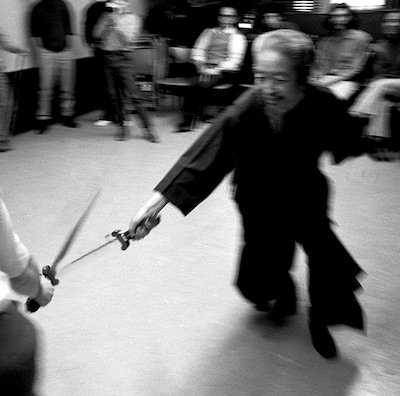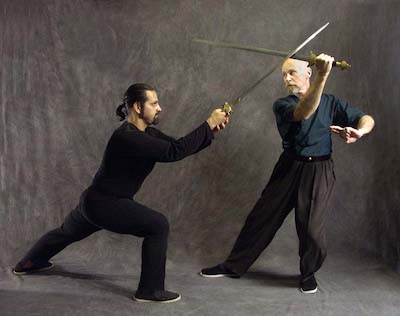It takes some skill to trim branches with a machete. It must be sharp, it must be wielded with speed and accuracy, it must move through the air in perfect alignment, and it must contact the branch at an angle for optimum severance. The tree does not help or hinder you in your ambition, it remains passive, and with practice it becomes easy to trim.

In duelling / fencing the O’s do not care to be trimmed. They are sentient beings and will do whatever they can to thwart your efforts. The more they practise the more difficult it becomes to ‘touch’ them and the more we need to improve our own skills. This is the process.
While fencing we are trying our skills as to the manipulation of an instrument and our ability to feel. We perceive the O’s energy and intentions, involving a transmission from person to blade to blade to person.
We are sending each other particular intelligence on our intentions, skill level and vulnerability. This feedback is apparent in all aspects of personal combat / sport, but it is the “Sine Qua Non”, the most important aspect of Tai Chi push hands and fencing.
There are many styles of Tai Chi and they may all practise different sword forms, but they do not necessarily practise fencing with the same goals in mind. Some people fence in order to become ‘duellists’, capable of life and death combat. Others are concerned with competing and with winning. They will ‘get us’ if they can, they will resort to the use of strength, speed and favourite techniques to win.
Those of us who follow the way of sensitivity can learn much by practising with fencers of that humour, but it must be done carefully.
For thousands of years swords were used with shields until it was discovered that the sword was capable of defence as well as offense, not only by blocking but also by sensing through the blade. Many of the most renowned swordsmen who have written books or have been quoted on the subject have spoken of this skill.
Author and Images: Ken van Sickle
German version on our sister site!
- ON BEING A MASTER – Tai Chi Sword 53
- STRANGERS – Tai Chi Sword 52
- PADDED SWORDS – Tai Chi Sword 51
- SAFETY – Tai Chi Sword 50
- PARALLELS – Tai Chi Sword 49
- Swordsmanship – SEVEN QUOTES – Tai Chi Sword 48
- TI FENG & FA JING – Tai Chi Sword 47
- SUPPOSITIONS – Tai Chi Sword 46
- LAO TZU (Laozi) QUOTES – Tai Chi Sword 45
- ETIQUETTE – Tai Chi Sword 44
- FENCING PROCESS – Tai Chi Sword 43
- STRATEGIES – Tai Chi Sword 42
- TASSELS IN THE WIND – Tai Chi Sword 41
- SHOOT FLYING GOOSE – Tai Chi Sword 40
- RHINOCEROS GAZES AT MOON – Tai Chi Sword 39
- THE MASTER SITS BACK – Tai Chi Sword 38
- FIVE APPLICATIONS – 1. BLOCK AND SWEEP – Tai Chi Sword 37
- RULES OF ENGAGEMENT – Tai Chi Sword 36
- CONSIDER – Tai Chi Sword 35
- INVITATIONS – Tai Chi Sword 34
- THE TASSEL – Tai Chi Sword 33
- THE SWORD FINGERS – Tai Chi Sword 32
- Cheng Man Ching Photographs
- THE JOINTS – Tai Chi Sword 31
- THE GRIP – Tai Chi Sword 30
- SWORD MOVEMENT – Tai Chi Sword 29
- ON ALIGNMENT – Tai Chi Sword 28
- CONCERNING THE CENTRE – Tai Chi Sword 27
- EQUATIONS – Tai Chi Sword 26
- HSIN AND CHI – Tai Chi Sword 25
- On studying – NINE QUOTES – Tai Chi Sword 24
- THE SWORD MAIDENS – Tai Chi Sword 23
- THE SWORD AND CALLIGRAPHY – Tai Chi Sword 22
- Returning – MORE THOUGHTS – Tai Chi Sword 21
- Levels of TAI CHI SWORD – Tai Chi Sword 20
- FENCING – Tai Chi Sword 19
- Transcendence – Tai Chi Sword 18
- TURNING TRICKS – Tai Chi Sword 17
- Names of CHENG MAN CH’ING’S TAI CHI SWORD – Tai Chi Sword 16
- FORCE – Tai Chi Sword 15
- DIFFERENCES – Tai Chi Sword 14
- BEGINNERS’ MISTAKES – Tai Chi Sword 13
- MIND SETS – Tai Chi Sword 12
- SENSITIVITY – Tai Chi Sword 11
- HARMONY – Tai Chi Sword 10
- TIME AND HUMOUR – Tai Chi Sword 9
- WHY AND HOW – Tai Chi Sword 8
- SWORD DIMENSIONS – Tai Chi Sword 7
- A ROYALTY OF ARMS – Tai Chi Sword 6
- KENNETH VAN SICKLE – Tai Chi Sword 4
- CHENG MAN CH’ING – Tai Chi Sword 5
- PREFACE – Tai Chi Sword 3
- Introductory Thoughts – Tai Chi Sword 2
- EDITOR’S PREFACE -Tai Chi Sword 1
- Tai Chi Sword by Kenneth van Sickle




